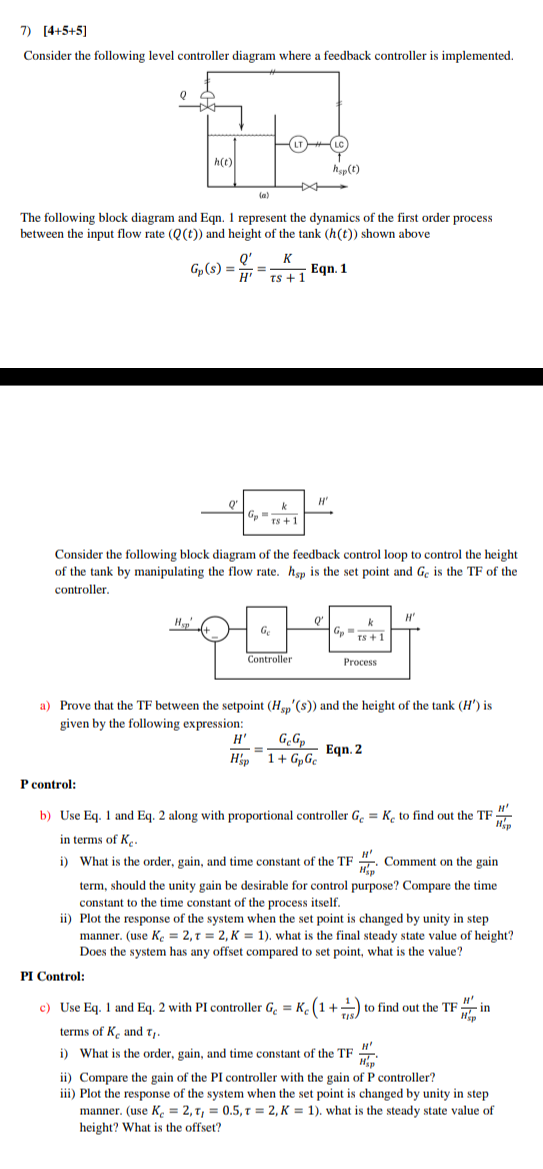Answered step by step
Verified Expert Solution
Question
1 Approved Answer
7) [4+5+5] Consider the following level controller diagram where a feedback controller is implemented. Q h(c) (a) The following block diagram and Eqn. 1 represent

7) [4+5+5] Consider the following level controller diagram where a feedback controller is implemented. Q h(c) (a) The following block diagram and Eqn. 1 represent the dynamics of the first order process between the input flow rate (Q(t)) and height of the tank (h(t)) shown above Q' K G(s) = Eqn. 1 H' TS + 1 H' O' G K TS + 1 Consider the following block diagram of the feedback control loop to control the height of the tank by manipulating the flow rate. hsp is the set point and Ge is the TF of the controller H Q . G Gp k TS + 1 Controller Process a) Prove that the TF between the setpoint (Hsp (s)) and the height of the tank (H') is given by the following expression: H' GEGP Eqn. 2 Hp 1+ GGC P control: b) Use Eq. 1 and Eq. 2 along with proportional controller Ge= K to find out the TF. Hp in terms of K i) What is the order, gain, and time constant of the TF Comment on the gain term, should the unity gain be desirable for control purpose? Compare the time constant to the time constant of the process itself. ii) Plot the response of the system when the set point is changed by unity in step manner. (use Ke = 2,1 = 2, K = 1). what is the final steady state value of height? Does the system has any offset compared to set point, what is the value? PI Control: c) Use Eq. 1 and Eq. 2 with PI controller Ge = K. (1+) to find out the TF; terms of K, and T. i) What is the order, gain, and time constant of the TF ii) Compare the gain of the PI controller with the gain of controller? iii) Plot the response of the system when the set point is changed by unity in step manner. (use K = 2,T, = 0.5, T = 2, K = 1). what is the steady state value of height? What is the offset? M' - in 7) [4+5+5] Consider the following level controller diagram where a feedback controller is implemented. Q h(c) (a) The following block diagram and Eqn. 1 represent the dynamics of the first order process between the input flow rate (Q(t)) and height of the tank (h(t)) shown above Q' K G(s) = Eqn. 1 H' TS + 1 H' O' G K TS + 1 Consider the following block diagram of the feedback control loop to control the height of the tank by manipulating the flow rate. hsp is the set point and Ge is the TF of the controller H Q . G Gp k TS + 1 Controller Process a) Prove that the TF between the setpoint (Hsp (s)) and the height of the tank (H') is given by the following expression: H' GEGP Eqn. 2 Hp 1+ GGC P control: b) Use Eq. 1 and Eq. 2 along with proportional controller Ge= K to find out the TF. Hp in terms of K i) What is the order, gain, and time constant of the TF Comment on the gain term, should the unity gain be desirable for control purpose? Compare the time constant to the time constant of the process itself. ii) Plot the response of the system when the set point is changed by unity in step manner. (use Ke = 2,1 = 2, K = 1). what is the final steady state value of height? Does the system has any offset compared to set point, what is the value? PI Control: c) Use Eq. 1 and Eq. 2 with PI controller Ge = K. (1+) to find out the TF; terms of K, and T. i) What is the order, gain, and time constant of the TF ii) Compare the gain of the PI controller with the gain of controller? iii) Plot the response of the system when the set point is changed by unity in step manner. (use K = 2,T, = 0.5, T = 2, K = 1). what is the steady state value of height? What is the offset? M' - in
Step by Step Solution
There are 3 Steps involved in it
Step: 1

Get Instant Access to Expert-Tailored Solutions
See step-by-step solutions with expert insights and AI powered tools for academic success
Step: 2

Step: 3

Ace Your Homework with AI
Get the answers you need in no time with our AI-driven, step-by-step assistance
Get Started


